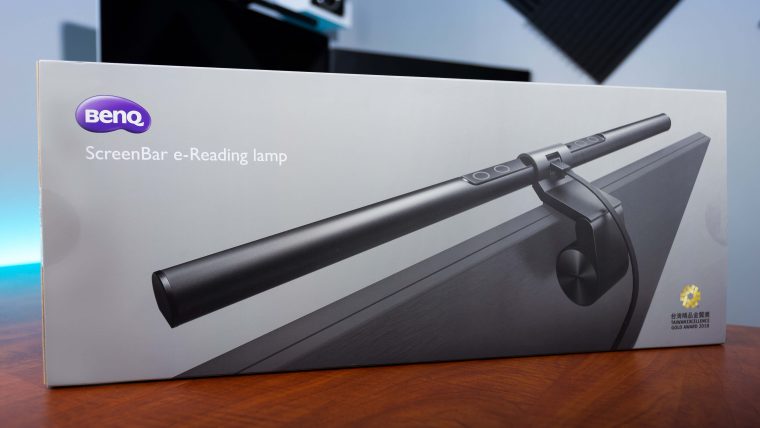
Have you ever considered using a monitor lamp? A monitor light bar offers many benefits and is a useful addition to your computer desk. This is especially for photographers and everyone else using graphic apps like Photoshop.
Table of Contents
Almost everyone uses a computer for work and personal use. Tasks like answering emails, filling out spreadsheets, browsing social media, and shopping all require us to look at a computer screen. By some estimates, we are sitting in front of screens 10-12 hours a day, and much of that involves a monitor we use for work.
Although you may not consider it so often, for thousands of years people have relied on light sources above them while they do their work on a horizontal surface like a table. Candles, chandeliers, and electric lighting have been standard sources of illumination, mimicking in many ways what is natural with the sun. Computer monitors are essentially a light source right in front of us. The wrong kind of lighting can cause short term and even long term side effects like headaches, neck pain, blurred vision, and eye strain.
For artists and photographers, complications from monitor usage can be an even bigger issue. That’s because while everyone is using monitors to work and take care of life tasks, people engaged in visual mediums for work or pleasure often need to take detailed, focused looks at what they are doing. The focus that a visual artist or photographer needs can result in long bouts of monitor time, which in turn can exacerbate some of the side effects people already feel while using a monitor.
Luckily there is an easy fix for these problems: a monitor light bar.
A computer monitor light or screen bar looks sort of like the same type of fixture you might see over a painting, providing some ambient light directly over the horizontal surface. A monitor lamp can provide some proper lighting in addition to the screen light itself, because the brightness of the screen can create its own set of problems for computer users, especially for those using a computer frequently.
Even if you have a curved monitor, there are lights that can accommodate a curved screen. Some of them may have features like adjustable brightness, which can be useful between day and night. But even if a bar doesn’t have 10 adjustable brightness levels, it will still provide a helpful light over the screen to reduce reflective glare and eye fatigue. Some of them have their own rechargeable power bank, while others must be plugged into a power supply.
While the light of the monitor illuminates whatever you’re looking at, it can also create huge amounts of eye strain. Some monitors, especially older monitors, use something called pulse width modulation (PMW) to assist in dimming the LED diodes that illuminate your screen. This particular way of dimming the screen can actually create subtle light pulsations that can in turn create eye strain and headaches.
Digital devices also emit something called high energy visible light (HEV), commonly called blue light. This particular light frequency has more energy than natural light, and can also pass through the eye more easily, hitting the retina and creating a number of side effects over time – one of which, incidentally, is trouble sleeping…which is why you should avoid using monitors before bed. In any case, a monitor light bar can help filter out some of these wavelengths through its projection over the screen.
If you work at night and have to turn other lights around you off, relying only on the glare of the monitor, a monitor light bar can bring some illumination to the otherwise poorly lit surroundings of your workstation, further reducing the amount of eye strain you experience.
Glare can be frustrating for anyone, but particularly frustrating for photographers and artists who may need to take close looks at specific details. If you do have other lights in the room, and they are on, some of these lights can create glare on the monitor screen. But if you turn them off, you may not be able to see other things on your desk or the blue light from the monitor might be too powerful.
The solution to this catch-22 is using a monitor light bar, which projects a soft light across the vertical surface of your monitor without making a direct, glare-causing impact. Remember that there will also be times when you work during the day (although many artists are partial to burning the midnight oil). If your studio or workstation is by a window or set of windows, this can create glare on the screen.
Many people like to place their home office in a space like a sunroom or Florida room, which is often sort of a side room built into a home or a deck transformed into an inner room since these spaces won’t interfere with people in the living room, den, or dining room, and people in those rooms won’t interfere with you while you play around with your Lightroom presets. A nice monitor bar light can eliminate glare from the sun by cutting across it before that sunlight hits the screen.
Another benefit to a monitor light bar is that it can provide some soft, subtle illumination for your desk, in addition to the benefits it provides vis-a-vis looking at your monitor. There are a number of things photographers might need to do on the horizontal surface of their desk, from turning the pages of an album to reading a book to examining some of their equipment.
A good monitor light bar can create some illumination for this immediate space without overpowering the rest of the room, which is especially handy if you have a home office or a small studio in the living room. You won’t have to worry about working late and keeping other people up with the small but focused illumination provided by the bar right above your computer screen.
Another benefit to a monitor light bar is saving desk space. This may not seem like such a big deal to most people, but to artists and photographers, it can be a make-or-break concern. You might have several cameras, books, bags of lenses, and perhaps some large paperback books on topics like how to use Photoshop 2022 new features.
You might also have a printer, a photo printer, and maybe even a hard drive or two for backup. There might be times when you want to spread some actual photographs out in front of your screen for inspiration or to help navigate a project. Whatever the case may be, not having some of your desk space taken up by a desk lamp is easily achieved by a sleek, compact monitor light bar above your computer screen.
Also, keep in mind that there is a good chance you will use the computer at your workstation for other things, such as answering emails, personal online banking, browsing social media, and shopping. Sometimes, these tasks necessitate having items on the desk (mail, invitations, purses, wallets, items to return). And other times you will want to read or work at the desk with an old fashioned piece of printed paper (hard to believe as it is). For those times when you need desk space, having it free and clear of extras like a lamp base will be appreciated.
Monitor light bars are not a built-in feature of your computer. They are portable and often fairly inexpensive. If you have several workstations around the house, or an office or studio outside of your home, or you’re frequently on the road shooting, a monitor light bar can become a piece of equipment that is easy to take with you.
Alternatively, since they are fairly inexpensive, you can also buy one for each of your workstations, or purchase one that is dedicated to laptop usage for those times when you need to work remotely or travel. Most lightbars are made to a sort of standard size that can accommodate a number of different computer models, so it’s something you can purchase for both your desktop and your laptop, or even a computer belonging to someone else that you might need to use at home base for a shoot.
Another benefit of a monitor light bar is that it just looks stylish. Most people walking by your workstation or seeing it out of the corner of their eye will not recognize all the benefits such a piece of tech equipment offers. But they will see something that looks very sleek and futuristic at the top of your monitor, creating a museum-like illumination over its horizontal surface in the same way that a painting light can illuminate a work of art on canvas.
In addition to the benefit of saving space on your desk by replacing a desk lamp, a monitor light bar can also replace the look of a traditional desk lamp with something a little more contemporary. If paired with something particularly eye-catching like a Razer Chroma multi-color keyboard (illuminated with an LED strip under each key), your workstation will look very exciting and might double as a great home base for gaming.
Another common problem associated with prolonged computer monitor usage is neck pain. The reason this happens is that usually the light coming from the monitor is not sufficient enough to help you focus on what is in front of you. At times, you may want to turn the light down, making it harder to see certain details. At other times, you may have the light turned up, making you lean back to compensate for the over-illumination.
It’s a sort of unhappy version of Goldilocks and the Three Bears, whereby nothing is ever exactly right. This means that you can, without thinking about it, place some strain on your neck. This is only compounded by hunched, uptight shoulders that can come from clicking on a keyboard or guiding a mouse around.
To alleviate one aspect of this problem, you might consider using a monitor light bar that can diffuse some softer, good quality light over your screen and make it a more balanced experience throughout your usage thereof. Without needing to use your neck to compensate for visual issues, you can work longer with less pain.
How many times do we suffer from irritating reflective glare during night work? If you can relate to the group of work owls, then you are obviously aware that inadequate lighting layout in your office can lead to eye strain and unwanted reflections over your working surface, especially when talking about screens and monitors by a desk lamp. This is why architects suggest to their clients to place furniture accordingly to a carefully planned lighting layout; yet somehow, we still manage to find ourselves in situations where the outcome is either: a) rearrange the furniture/lighting or b) deal with it the screen glare.
You can say then: yes, of course, I can change the lighting or move the furniture to improve the computer screen lighting. That’s not always the best option for some when working in reduced spaces, or if you have fixed luminaries in your office. Deal with it? Better no, as continuous exposure to bad lighting situations can accentuate eyesight strain, leading to a huge list of side effects ranging from constant headaches while working to requiring prescription glasses to work.
So, how can we solve that kind of situation if our work depends exclusively on digital imaging? BenQ seems to have found the answer to that question with their latest innovation to the monitor light market: The BenQ ScreenBar.
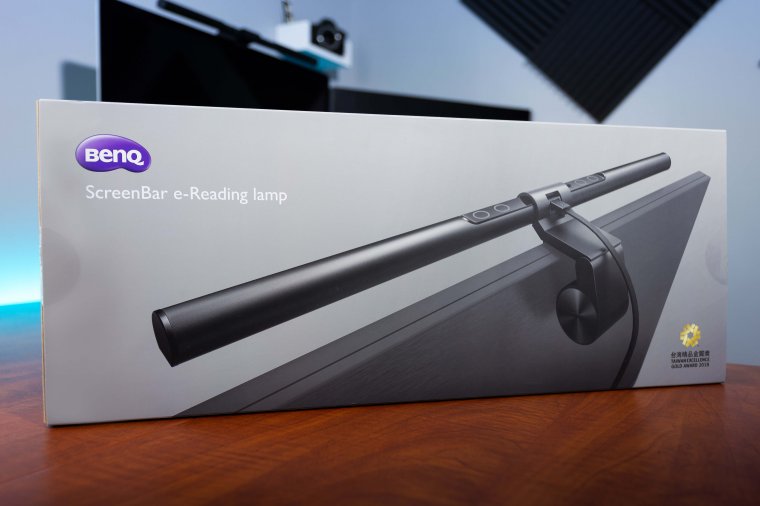
For those unaware of what we are talking about, BenQ has managed to arrange a kit of LEDs of 800lx intensity in an 18-inch wide aluminum tube, whose section is ¾” in diameter. That interesting LED tube is held by a counter-weight mounting system that has to be attached to our monitor or display, and also allows a slight tilting for this bar to improve the lighting conditions of the user whenever needed.
Sounds interesting? Let’s keep discussing some cool features about this new gadget!
The BenQ Screenbar stands out not just for being an innovative answer from a leading brand in the industry, but also for its minimalistic design. The bar will show up a bit on top of your monitor as it was the best way to allow the tilting angle for the bar to be put in action, and that very clawish system used to hold the bar is placed at the centre of the screen bar itself.
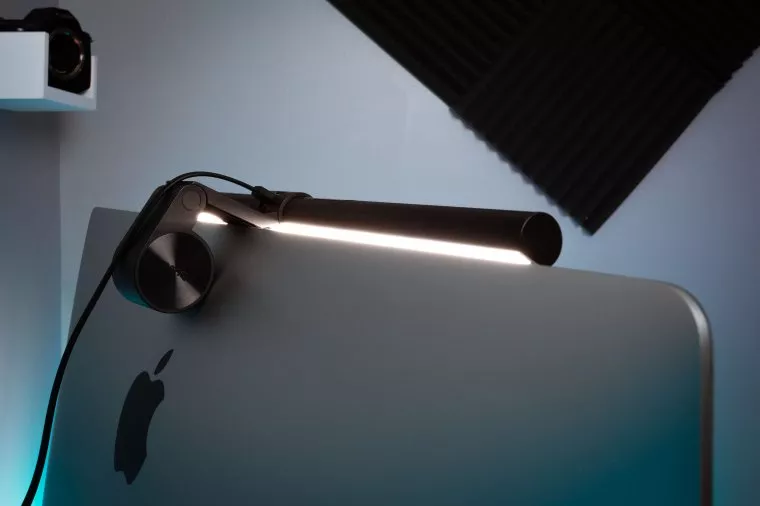
From behind, the USB power cable is plugged at the rear part of the connection between the mount and the lightbar, setting the cable direction to be placed on top of the mount and going under until it reaches the most proximal USB outlet to be powered. The cable length is 60-inch long, with a MicroUSB to USB-A connection.
Though the Screenbar does not come preassembled with the monitor mount, users have to do it manually. Do not fret as the process is absolutely simple and guided with clear instructions; it won’t take more than some seconds to get everything to work.
The aluminium alloy finish comes as an added value, as one can expect this kind of product to be produced in a glossy plastic finish, which, fortunately, isn’t the case. Not only it’s easier to clean it with the usual electronic appliances cleaners, but also adds in what resistance respects – this is a product to be used for long-term and also targeted for those users who value design above all things thanks to its minimalistic profile.
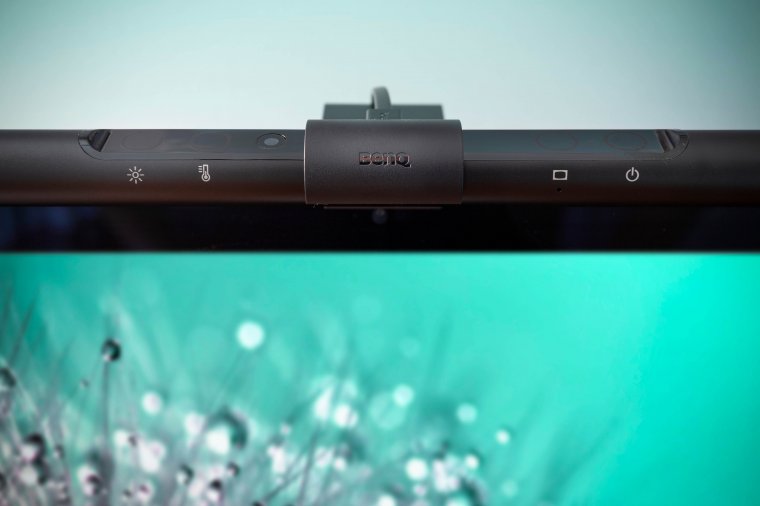
First and foremost, you need to take into account the size. By being 18-inch long, this screen bar is best suited for monitors of 23” size onwards. It won’t fit your laptop’s 15” display, and for those using 17.3” laptops, it would look somewhat odd, as the bar will go further than the display’s size. Actually, this is a product intended for a bulky desktop computer monitor that can also support the added weight of the bar – which isn’t that much, a bit over one pound. It does work for a curved monitor, but overall, it won’t stick just to what’s in front of your display but also cast direct illumination over your desk space – something that we just loved! It’s so much better than a traditional desk lamp.
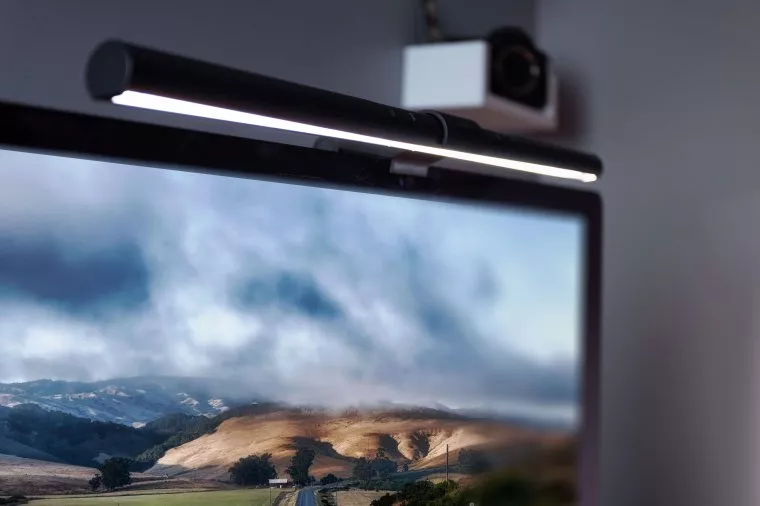
There are four buttons on top of it, easy to access as there is a pronounced bezel around the area, plus that part comes flat unlike the rest of the bar. The buttons are a manual dimmer, hue adjustment, auto dimmer and, obviously, the power button. These buttons are touch-sensitive, and to enable the hue adjustment mode or to dim the brightness you just have to tap and hold the button for a brief moment.
There’s an auto dim button as we mentioned, which works with the ambient lighting sensor paired with this unit. When enabled, the auto dim button will set the brightness and a green LED will power on below the button to let the users know that the auto dimmer mode is turned on.
Another cool feature of this ScreenBar monitor light is the glare free ambient light sensor, which by using the aforementioned sensor will adjust the brightness and color temperature accordingly to your room’s condition to reduce eyes strain from prolonged computer use – by far much better than sticking to third-party software to reduce blue light emission. The ambient light is limited to a 500lx.
The ScreenBar, thanks to its mount, allows a tilting angle of 20º either backwards or forward. By tuning-in your preferred angle, the ScreenBar can easily replace your usual lighting layout as, believe us, the light intensity provided by this bar is considerable.
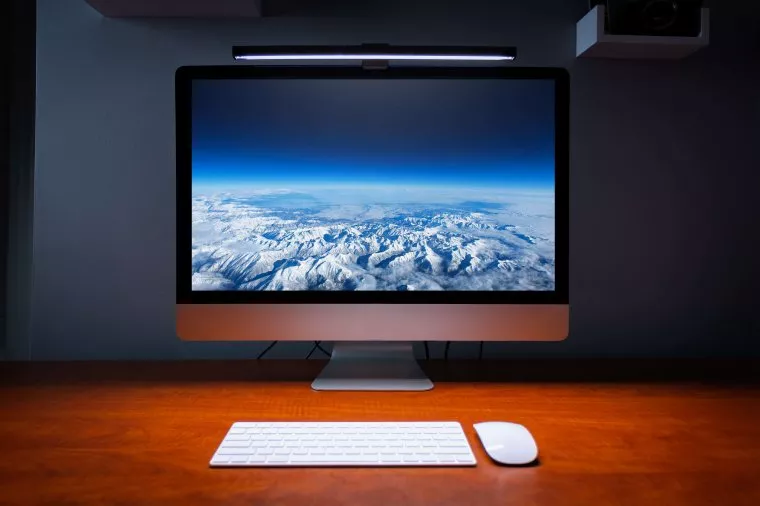
We can also adjust the lighting temperature for the emitted light thanks to being built with two types of LED lighting: cold light and warm light. The color temperature range can vary from 2700K to 6500K; and if you prefer to go to one extreme, let’s say 6500K cold lighting, the warm light LED is turned off to avoid wasting energy and overheating. For a device that works with a 5V USB Port connection with a power consumption of 5W, it’s quite impressive as it’s extremely cost-benefit for us users to stick to it. If, in turn, you desire to set a custom value in lighting temperature, both types of LED lighting will mix to give you the desired white balance you prefer.
For us, this was a truly pleasurable product to test. Overall, it does what it promises and much more; you can easily get accustomed to the lighting it emits, and for prolonged use, it’s best to pair it with dedicated computer glasses as it’s the case of Gunnar Optiks eyewear products or similar if your intention is to reduce eyesight strain and end eye irritation symptoms.
The weight is something to take in consideration if working with multiple monitors, or if you already own a very bulky unit with a not-so-reliable mount. With a BenQ monitor, it’s fair to say that you won’t experience any issue at all as it was designed with their usage in mind, but it can perfectly fit other units as we tested with an iMac Retina 5K 27″ display. Similar BenQ Screen bar products include the BenQ Screenbar Lite, Screenbar Plus, and Screenbar Halo,
All in all, it’s a gadget worth acquiring if you are either a professional working in photography/videography or computer graphics with long nights of work to put ahead, or if you are a college student that requires long hours of studying and note-taking. This light bar certainly improves the experience and gives an well-spread lighting for your working area.
You may want to consider buying the Quntis LED Monitor Light – one of the newer solutions for screenbars in the market. But first, let’s cover some basic stuff.
When looking for creating the perfect workspace area, one of the often-overlooked elements is proper lighting setup. This has multiple long-term effects, the most recognizable one being the gradual loss in visual acuity thanks to visual strain, but also migraines, poor back posture, and many other aspects that considerably damage your health and lifestyle can be linked to poor work lighting conditions.
For this reason, you should always count on one general light for the room – diffuse, and an accent light on your desk area for those tasks that require extra focus. The light should be practical to be placed wherever is needed, and it would be a plus if you can dim it to match the lux requirements for each task. Another element to consider are glares – hence the reason why desk placement is so important, the incidence of natural lighting into our computer’s screen, and also any kind of specular reflection coming from either light sources or other screens – as it’s commonly seen in those home offices that also host entertainment areas such as a TV.
BenQ has been the leading solution in the market so far with the innovative creation of their BenQ ScreenBar a couple of years ago, and its revised version, the BenQ ScreenBar Plus. The advantages that screenbars offer in contrast with common table lighting fixtures is that you don’t need any extra space to host them: they sit right on top of your computer screen (and yes, that also applies for laptops depending on the size of the laptop itself and the screenbar model you buy). Such a comfortable solution for increasing the available light in your work area also boosts a minimalist workspace where you don’t need to bother about wiring mess and many other setbacks commonly associated with office life.
In most cases not, again this depends on the built of the light bar you buy. For the Quntis LED Monitor Light, its 54 LED modules are not only strong enough to cover your work light area but also ensure that the lighting angle doesn’t directly bounce off your display, and for that reason, glare won’t happen (a blessing for those of us who suffer from long-term screen exposure).
Yet still, a word of advice: don’t try to point the light source directly to your eyes. 54 LEDs are serious business and you could end up damaging your eyes by “experimenting” with the said scenario.
This lamp, unlike some other cheap options in the market, has a strong built meant to last for many years, but the mounting solutions for the monitor are an entirely different issue we want to address later on.
This lamp has great pricing for the value it offers – being about $100 less or more than the price you have to pay to afford the BenQ models, but it does have some limitations that are expected for such a cheap price.
For the lighting angles, this screenbar can be tilted up to 45 degrees, which means you can cover your entire keyboard without any issues. Even up to said angle, the light won’t bounce and you see a very clear light trajectory upon your desk.
Its connection interface is USB-A, making it compatible with any laptop available in the market and also outdated models that don’t count with USB-C ports. Don’t try to use it with a USB hub or USB extender as the light won’t turn on, as we have seen with the BenQ models. The physical switch is quite handy if you don’t want to be touching the buttons on the bar itself – which, we should add – are extremely sensitive to input.
You can’t ask a budget screenbar to behave like a top-tier product, but still, some aspects should be revised by Quntis for upcoming versions.
The first drawback of this screenbar is the mount. It can work well with laptops, but for some monitors is somewhat of a nightmare. We tested it with a 27” iMac and the result was horrible as the mount kept moving, and whenever you reached for the controllers on top of the bar the mount kept changing the bar position as it wasn’t nested as it should be. The same scenario happened with an LG Ultra-widescreen monitor, so we have to assume that the mount isn’t designed for monitors with big curved parts on their back.
The position of this mount didn’t help the in-built webcam that the iMac has, so the option was to either aim to move it a bit above to be able to host web conferences, or simply remove it, which is not the intention when you buy a screenbar. It’s not as distractable as a clip-on webcam, but you need to get used to its position, which can take a while.
Finally, the second setback we found was that the lighting setups for color temperature were limited. Either you could get a really cool blue, a neutral white, or a very warm light instead of being able to explore the full light spectrum as we have seen with both BenQ models. More versatility could really help users to find their sweet spot for using the screenbar according to their room color and mood, instead of lighting setup configs that mostly resemble presets for lighting instead of a fully customizable experience.
All in all, if you are looking for a budget solution or if you work in a pretty much-restricted work area, this is a good option to experience the screenbar hype (and take some cool photos for your social media).
If you are looking for performance without minding the money spent, go with the BenQ models, but do keep in mind their short cable – something that Quntis did right with their cable length to connect this lamp.
A screen bar or monitor light bar helps reduce screen glare and screen reflection. Some of them can alternate between warm light and cool light, which can be helpful for working with different color palettes – a nuance you might get initiated into when working with Lightroom tutorials.
Additionally, a screen light bar can free up valuable space that would otherwise be claimed by a traditional task lamp or desktop lamp. It can also cut down on the problems that are inherently associated with extensive monitor usage, such as eye strain and headaches.
From the Benq Screenbar to the Quntis LED Monitor Light, there are a number of options to choose from no matter your price range.